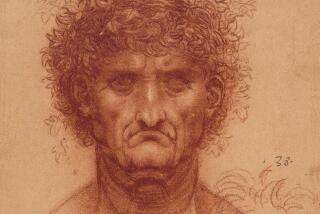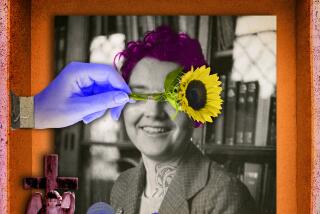Chew on this
- Share via
MORE than a decade ago, a British nun with an overbite and a girlish voice became a TV sensation. Sister Wendy Beckett made paintings accessible to a mass audience the way that Leonard Bernstein made classical music interesting for children. Her approach was simple. “People who go to the museum are not asked, luky them, to hold forth about these works,” she told an interviewer. “My struggle has been to let them know there is something there to respond to and for them to respond to.”
“Something there.” Codes have long been the stock in trade of classical artists, their way of leaving private signatures on works hanging in the palaces of the mighty. But Dan Brown and his imitators -- which include (though unfairly) Javier Sierra -- have taken Sister Wendy’s “something there” and blown it to conspiracy-sized proportions.
Milan in the late 15th century is a conspiracy-ridden hot spot troubling the Vatican in Sierra’s “The Secret Supper.” Rome has many problems as the novel opens: Christian civilization is teetering between “Turkish hordes armed to the teeth” and European rulers “seduced by the beauty of all things pagan.”
Then letters start arriving from an elusive figure called the Soothsayer; he warns that serious heresies are being committed by Leonardo da Vinci, who is working in Milan under the patronage of the city’s duke, Ludovico Sforza. True to the picture given us by historians, Sierra’s Pope Alexander VI is a conniving figure who fails to see how a painter can threaten his empire.
“Art is the most essential of your weapons, Holy Father!” one of his exasperated underlings tells him. “Have it always at your service and you’ll dominate all of Christendom. Lose it, and your entire pastoral mission will fall to pieces.”
Sent to Milan is the Dominican priest Agostino Leyre, a student of symbolism worthy of Umberto Eco’s Brother William of Baskerville in “The Name of the Rose.” Leyre arrives during one of the “cruelest winters in memory” and takes lodgings at the monastery Santa Maria delle Grazie, where Leonardo is painting his “Last Supper” in the refectory. The Soothsayer calls the painting an essential part of Ludovico’s plan to create “a pagan republic in the very heart of Italy.”
Many of the clergy are uneasy about the painting. The arrangement of the figures, the choice of objects on the table and the apostles’ body language shimmer with an aura of secret meanings in an age “in which every lord, every prince, every cardinal has so many things to hide from the others.” Why, a monk asks, don’t Christ and his apostles have halos? Another inquires: “[W]hat of the Eucharist? If this is, as he claims, the Last Supper, why does Christ not have before him the bread and the wine to consecrate? Where is the cup of the Holy Grail?” Sierra’s prose is at its best as he probes the possible answers.
Some readers have complained that Dan Brown’s storytelling isn’t very good in “The Da Vinci Code” -- he uses too much gimmicky suspense, and encyclopedic chunks of information spill out of characters’ mouths instead of credible dialogue. Sierra’s narrative moves smoothly, fluidly, as Leyre hunts for the Soothsayer and studies the painting. His Leonardo is a smug genius who never gives a direct response to a direct question and adopts an unusual technique in the hope of protecting his painting. “Why do you think I’m painting it on a wall and not on a canvas?” the maestro asks his apprentices. “It’s so that no one may unhook it or force me to redo it.”
Sierra populates his narrative with predatory art dealers, sexually precocious young women and earnest, clear-eyed heretics -- all with agendas half-hidden and mysterious. Few murders occur, but when they do, they mirror biblical texts in the same way that deaths in Matthew Pearl’s “The Dante Club” resemble the tortures of the damned in the “Inferno.” The body of the monastery’s librarian, for example, is found hanging from a window on Friday the 13th. The fact that he was helping Leyre and had modeled for the figure of Judas leads to obvious questions: Whom did he betray? Why was he punished Judas-like?
Sierra, a television personality in his native Spain, believes he is doing more than writing a novel, more than simply finding a useful mystery and designing a narrative to exploit it. In interviews and on his website, he explains that literature can solve genuine mysteries; his past novels have delved into enigmatic aspects of the Knights Templar, apparitions, Napoleon and the pyramids at Giza. The questions his characters ask about “The Last Supper” are clearly his own.
Sierra dispenses with the whole the-apostle-seated-next-to-Jesus-is-a-woman revelation of “The Da Vinci Code” with a simple explanation: In the novel, a girl sits for Leonardo as a model for John the Beloved Disciple -- both as a joke and to capture his youthfulness among a group of crusty old fishermen. As a stand-in for Sierra, Leyre is less interested in John and more intrigued by the figure of Jesus: “If you look at His body, with His arms stretched before Him, you can see that He has the shape of an enormous letter A.” As an apprentice notes, this is because “He’s the Alpha that rises in the midst of the chosen twelve.”
Or else it’s because, as Leyre realizes, this letter is part of a word that Leonardo wants everyone to read.
Leyre’s search for the other letters is exhilarating, and once you’ve finished with Sierra’s speculation into the meaning of “The Last Supper,” you may not wonder anymore why his book and others like it have invaded bestseller lists. They make art history palatable and exciting for a large audience. Move over, Sister Wendy. *
More to Read
The biggest entertainment stories
Get our big stories about Hollywood, film, television, music, arts, culture and more right in your inbox as soon as they publish.
You may occasionally receive promotional content from the Los Angeles Times.










